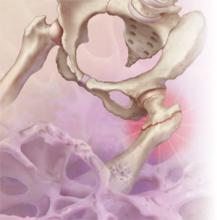An estimated 10 million US residents, most of them women over the age of 50, suffer from osteoporosis, and another 33 million have low bone mass.1 Together, they incur more than 2 million osteoporotic fractures annually.1,2 In addition to the high cost of a single osteoporotic fracture in terms of morbidity, mortality, and health care spending, individuals who sustain one such fracture are at high risk for another. That risk can be greatly reduced with appropriate treatment.
Bisphosphonates, which act on osteoclasts to inhibit bone resorption, are first-line therapy for prevention of osteoporotic fractures. Four bisphosphonates—alendronate, ibandronate, risedronate, and zoledronic acid—are approved by the US Food and Drug Administration (FDA) for the treatment of postmenopausal osteoporosis.
While menopause itself increases a woman’s risk for osteoporotic fracture, questions remain about when to initiate preventive therapy, which patients are candidates for bisphosphonates, and whether bisphosphonates are effective for primary as well as secondary prevention. This overview from the Cochrane Musculoskeletal Group (CMSG) addresses those questions.
To help you provide optimal treatment for postmenopausal patients, we present the findings of recently conducted systematic reviews of 2 bisphosphonates—alendronate and risedronate—from the Cochrane Database of Systematic Reviews,3,4 in context with the available evidence on the efficacy of ibandronate and zoledronic acid. Cochrane reviews of ibandronate and zoledronic acid are underway, but not yet completed.5,6
This is the second in a series of articles based on the findings of the Cochrane Musculoskeletal Group (CMSG), one of the largest review groups in the Cochrane Collaboration. The CMSG synthesizes the results of high-quality clinical trials to determine whether interventions for the prevention, treatment, and rehabilitation of musculoskeletal disorders are safe and effective. In this article and those that follow, CMSG’s aim is to bring its findings to the attention of family physicians in a context that is relevant to clinical practice.
Alendronate reduces vertebral fracture risk across the board
Wells et al identified 11 RCTs for the alendronate review (3 primary and 8 secondary prevention trials), representing a total of 12,068 women.3 (For definitions of what constituted a primary vs a secondary prevention trial, see the box.)
Doses of alendronate ranged from 1 to 20 mg daily, with most studies using doses of 5 or 10 mg. Treatment duration ranged from 1 to 4 years.
A look at the relative risk (RR) for primary and secondary prevention at different fracture sites (TABLE 1) highlights similarities and differences. The risk reduction for vertebral fractures was statistically significant—and about the same—for women being treated with alendronate for primary and secondary prevention (RR=0.55; 95% confidence interval [CI], 0.38-0.80; RR=0.55; 95% CI, 0.43-0.69, respectively). For all other (nonvertebral) fractures in patients being treated with alendronate, only the outcomes for secondary prevention were statistically significant.
The Cochrane reviewers studied the effects of alendronate and risedronate3,4 for both primary and secondary prevention of osteoporotic fractures in postmenopausal women, using the following definitions (with slight variations in definitions between trials):
Primary prevention. Randomized controlled trials were classified as primary prevention trials if the participants had baseline T-scores >–2.0 or a baseline prevalence of vertebral fracture <20%.
Secondary prevention. Studies were classified as secondary prevention trials if the women had baseline T-scores ≤–2.0 (ie, bone mineral density [BMD] ≥2 standard deviations below peak bone mass) or previous vertebral compression fractures. (In the ibandronate individual patient meta-analysis,14 secondary prevention was defined as lumbar spine T-score <–2.5 or baseline vertebral fracture prevalence >20% or mean age of participants >60 years.)
Age-based criterion. When data on T-scores and/or vertebral compression fractures were unavailable, age was the determinant: Trials were considered secondary prevention if the average age of the participants was >62 years, and primary prevention if the average age was ≤62.
Risedronate is effective only for secondary prevention
Seven RCTs, including 2 primary and 5 secondary prevention trials, were included in the Cochrane review of risedronate, representing a total of 14,049 women.4 Doses ranged from 2.5 to 5 mg daily, but also included cyclical dosing—for example, taking 5 mg/d for the first 2 weeks of every month. Treatment duration ranged from 2 to 3 years.
At doses of 5 mg/d, there were no statistically significant decreases in fracture risk at any site in the primary prevention trials (TABLE 1), although the quality of evidence assessed was low. For secondary prevention, however, the risk reduction for vertebral fracture was significant (RR=0.61; 95% CI, 0.50-0.76), as were the reductions in risk for nonvertebral and hip fractures.


